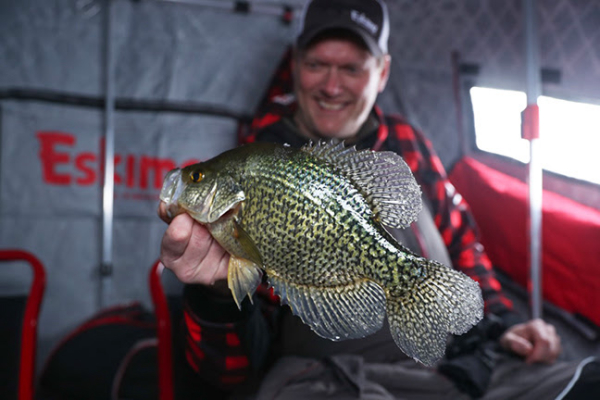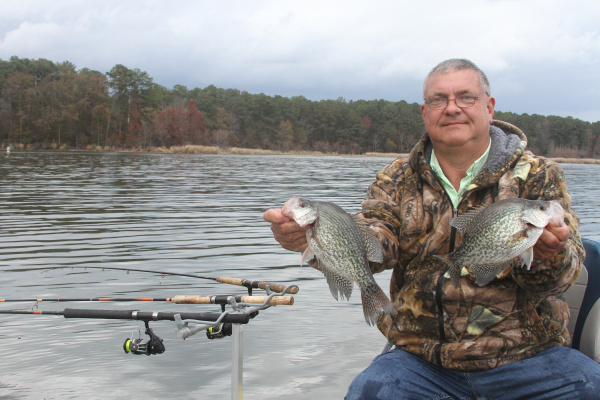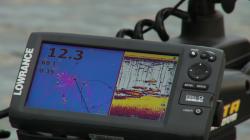
| Time for Lunker Panfish By Frank Sargeant, Editor from The Fishing Wire While most anglers are still focused on spawning largemouth bass in late April across the South, a few savvy panfish anglers know that this is the time to home in on catching the largest bluegills, warmouth and crappie of the year as the “jumbos” cruise into the shallows to feed on bass fry around the beds. Crappies spawn earlier than bass, bluegills and warmouth later, but both species love 1 to 2 inch long baby fish, and with the bass spawn beginning in late March and continuing into early May, there are millions of these fry in the shallows of many lakes at present. While small bluegills and warmouth mostly eat grass shrimp and insect life, the hand-sized “jumbos” seem to prefer fish. Crappies, of course, feed heavily on minnows of all types throughout their adult lives. Bream beds are not hard to find—or at least that’s usually the case. This year, high, muddy water in many lakes around the Southeast has made it more of a challenge to pick out the beds. They’re shallow bowls scooped out on firm sand or shell, typically in 1 to 4 feet of water on the edge of grass, or around boat docks, stumps or other cover. They’re easiest to see on a calm day with high sun. This year, the challenge is just finding water that’s clear enough to see down any depth, but barring further downpours, the water should clear quickly. Beds that hold panfish may or may not have adult bass still in them. While the male bass guards the nest for the first week to 10 days after the eggs hatch, they leave them on their own after that. Big panfish prowl around both guarded and unguarded nests. Matching the hatch is the sensible way to catch these panfish, which often are far bigger than typical schooling bluegills or crappies found offshore. Tiny 2” floater-diver minnow imitations from Rapala and Rebel are particularly effective. These fly-weight lures are best fished on ultra-light spinning gear and 6-pound-test mono—heavier line ruins the action. It’s also essential to tie them on with a loop knot like the turtle rather than a uniknot or improved clinch, because if the knot draws tight on the eye, the action of the little lure will be ruined by the resistance of the line. A little reel like the Shimano Syncopate 1000 is all that’s needed to handle the lightweight minnow imitations from Rapala and Rebel that attract these jumbo panfish. Fly rod poppers also work well when the panfish are around the beds—choose light-colored bugs with minimal dressing, because in this case you’re imitating a minnow rather than a bug or a frog. Sometimes all it takes is casting the lure over the bed, letting it set for a 10-count and then twitching it once—bluegills in particular like this presentation. I’ve caught some close to a pound with this tactic this spring. Crappies and warmouth, on the other hand, seem to like a moving target. Slow cranking the bait so that it comes wobbling across the bed and nearby shallows draws the strikes. When you catch a panfish off a bed, the disturbance flushes most nearby panfish for a time, but sit quietly for 5 to 10 minutes and they’ll come cruising back to the free feast. You can probably catch another and then another with well-timed casts. It’s also possible to catch these fish with tiny jigs of 1/32 ounce or there-abouts, again fished on UL tackle. The smallest Beetle Spins also work well, cranked just fast enough to make the spinner blade turn. For fly-rodders, a silver/green streamer fly about 2 inches long on a size 8 long-shank hook does the job. Very short, jerky strips of an inch or so at a time draw the bites. While panfish are the primary target, fishing the beds with this gear also occasionally turns up a surprise. This spring I’ve caught black drum, catfish and perch in these areas and also landed bass to a couple pounds, a real handful on the ultra-light gear. It’s a change of gears for those of us who are confirmed bass-heads, but a pleasant diversion for a few weeks in spring—and when it comes to eating, you can’t beat fresh-fried fillets off these oversized panfish. |





